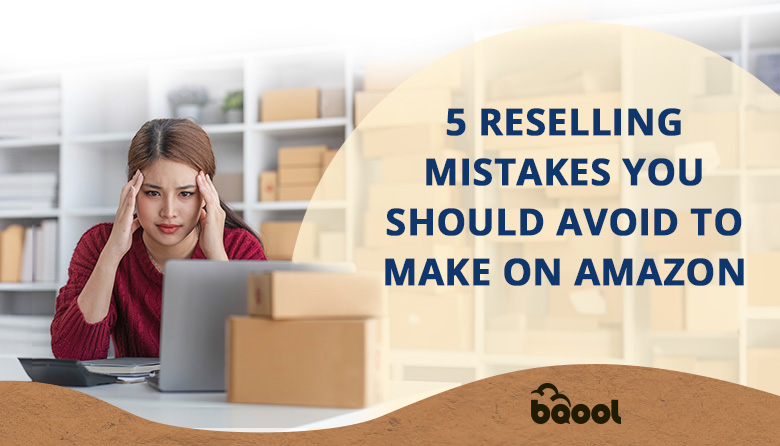5 Reselling Mistakes you Should Avoid to Make on Amazon
The first decision that you make when you resell on Amazon is decisive of your future success and profit. That is why you need to pay attention to and put some extra effort into sourcing your products since everything is ultimately connected to this very first step of the reselling process, just like a race, you do not want to miss the starting pistol!
In today’s article we will talk about the 5 common reselling Faux-Pas, you should avoid making on Amazon to be successful. Let’s start on the right foot and become a profit machine!
Sourcing the Wrong Items
This is the first step to reselling, and it is arguably the most important step that you need to be meticulous about. Identifying the right product(s) could be difficult and if you do not know where to start from you can check for ideas online like Pinterest (https://blog.bqool.com/promote-amazon-store-via-pinterest/), but keep in mind that what worked for other sellers might not work for you, every situation is unique. We encourage you to spend enough time scrutinizing the product’s potential. Don’t forget to always check for the product quality, lest you end up with a product that will cost you a leg without being able to resell it. You also want to make sure that you never eat more than you can chew, this means that you never pay too much for any items you want to flip and never buy a huge quantity of items to resell. Once your chosen sourcing method, whether it’s online arbitrage, retail arbitrage or replens, has lined up with your business expectation, you can prepare to sell what you have sourced on Amazon. You can check this article for inspiration.
Being In Denial
If you are not making profit for a while, it might indicate something is wrong, right? But you still want to believe there is some hope and you will eventually sell the products you have recently sourced. After all, we understand this false sense of hope. This is symbolic to your denial of reality, you have invested time, money, and energy in the item(s) you have sourced, and you do not want to let it go yet and cut the loss before prices start falling off the cliff.
Refusing to face the reality of a situation could have a dramatic impact on the profitability of your Amazon store. So, stop lying to yourself, face the unpleasant truth that you will need to sell at a loss on items that are not moving to avoid irreparable damage to your business.
Setting up Prices Too High…
It may seem like some successful sellers out there have some mystical ability that gives them the power to succeed and make tons of sales in one week, but the truth of the matter is that success on Amazon is not about magic or luck, it is about having achievable goals and competitive prices. Rome was not built in a day, and neither will success come instantly. Of course, having great profits is your focus when you are reselling on Amazon, that is why It is important to have realistic goals, so do not get too crazy with your prices, you do not want them to be so high that no one will buy from you. Sourcing smartly and setting up reasonable prices are the keys, so make sure you get it right! Making smart sourcing decisions will set the foundation for successful sales, so consider this carefully.
…or Too Low
We know that reselling on Amazon can be difficult sometimes and the results that you might obtain are far from your expectations. After all the efforts you put into it and the money you have invested in it, you can’t see the results of your hard work, and this is where starts the spiral of despair and bad decision making. You know Amazon is super competitive, and we know, “desperate time calls for desperate measures”, you might be tempted by selling your items at their lowest prices and this is a bad idea. Also, you have to keep in mind, if your prices are too low, Amazon can choose to deactivate your listings that you have set up too low prices. Finally, do not point fingers at the repricer for not working properly if you set your min price too low. If other competing sellers who are penny cutting your offer, and you know you can still sell the item at a profitable price, you want to wait till the penny droppers to sell out and you can price your item at a reasonable price. Chasing for the lowest price is never a viable strategy on Amazon.
Expecting the Repricer is Going to do Everything on Your Behalf!
Many sellers have a lot of expectations with tools that are powered by AI. As smart as AI can be, expecting it to make decisions on your behalf and take care of the whole process is like something out of a sci-fi movie! We still have quite a long way to go before we can make Jarvis from Iron Man into a reality.
So, we would like to remind you that a repricer is an automation tool that can automatically adjust the prices of your listings according to the Amazon marketplace. But for it to work properly, it requires that you provide instructions. Keep in mind that unrealistic expectations will likely be the main cause of any disappointments in terms of performance. To ensure optimal results when selling on Amazon, be reasonable when you are setting the min and max prices for your items, readjust your expectations and most importantly, you will need to choose a repricing that is powered by AI and machine learning.
If you want to have a detailed explanation to learn how AI repricer works, you can check this article.
Selling on Amazon is hard, but with the help of a repricer, it makes a seller’s life easier. Doing business on Amazon still requires a lot of patience and investment from anyone who is serious about eCommerce. That is why sourcing is such an important part of the reselling process. Do not get trapped in a loop of bad choices, start on the right foot and you will be sure to make a profit. As another friendly reminder, do not bother wasting your time sourcing products that you already know you may not make any money on because the procurement of these items is too expensive, or the demand for the products is low. Finally, have realistic goals and you will start to see the money pouring into your bank account.














